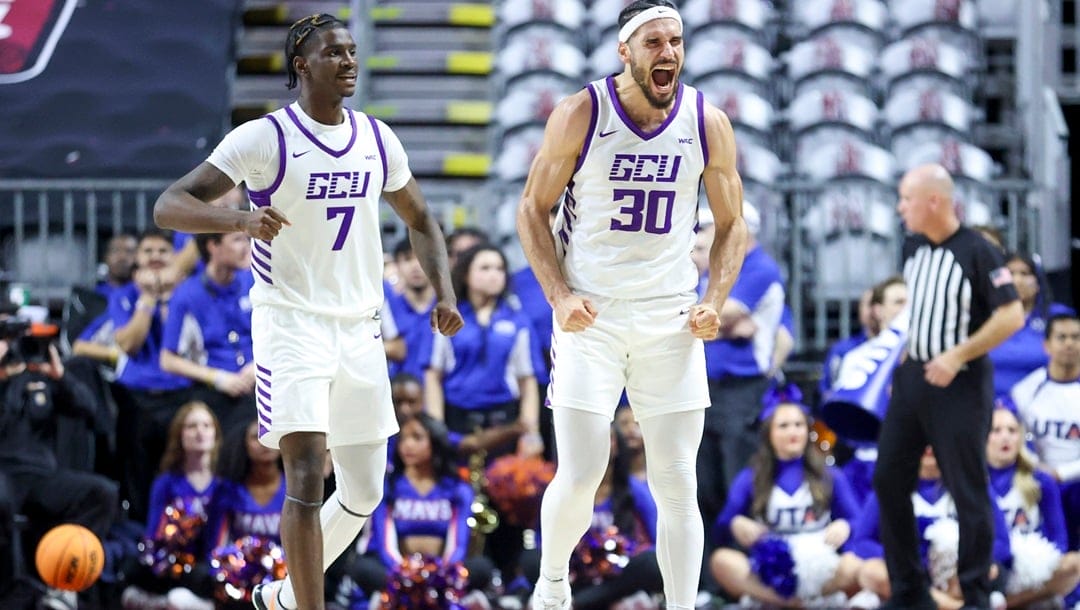- Everyone loves to hunt for upsets in their March Madness bracket.
- NC State is the most popular Sweet 16 futures ticket at BetMGM.
- Grand Canyon has the shortest Sweet 16 price of any single-bid league champion.
When it comes to March Madness brackets, everyone knows the deal.
A correct upset pick is worth its weight in gold. (If you’re betting into the college basketball odds market, it can quite literally be worth some gold.)
I’m hammering out a lot of good NCAA Tournament content right now, including these First Four best bets and lots of ongoing analysis of the college basketball national championship odds.
If you’re looking for some outright upsets to bet on, or maybe even just looking for a few good sleepers in your bracket pool, you should strongly consider a few of these picks.
From internal data… most popular Sweet 16 futures bets at @BetMGM:
NC State +500 (8.1%)
McNeese +700 (4.9%)
North Carolina -200 (4.5%)#JMU +700 (4.4%)
Kentucky -145 (2.9%)
Grand Canyon +500 (2.9%)
New Mexico +250 (2.7%)
Oregon +450 (2.7%)#UVA +1700 (2.3%)— Chase Kiddy (@chaseakiddy) March 19, 2024
Most Likely March Madness Upset: No. 11 New Mexico
Plenty of bracketologists and college basketball experts have big opinions on what will happen in the tournament. Some of them will be right; many of them will be wrong.
One of the surest places you can turn for smart, unbiased opinions is actually the sportsbooks themselves since the odds imply plenty of things about specific matchups.
In Friday’s first-round game between New Mexico and Clemson, the Lobos are a -135 moneyline favorite despite being a No. 11 seed playing a No. 6 from the ACC. New Mexico also has the best Sweet 16 odds of any double-digit seed.
In the eyes of your friends and coworkers, a correct 11-over-6 pick is incredibly impressive. In the eyes of the sportsbook, though, this wouldn’t even be an upset.
Best Cinderella Picks: No. 12 Grand Canyon
New Mexico is the auto-bid winner from a conference that put six teams in the field of 68, so you might not be inclined to think of the Lobos as a traditional Cinderella.
So, if you’re looking for a slightly glassier slipper, take a look at the Antelopes. They have been pouring funding into their men’s basketball program in anticipation of an eventual tournament run. This could be the year.
Of all the one-bid league representatives, Grand Canyon (+500) is the most likely to make the second week of the NCAA Tournament, at least according to BetMGM’s futures odds. The next closest is No. 10 seed Drake, winner of the Missouri Valley, at +575.
Predicted Upsets March Madness: No. 11 NC State
As a BetMGM writer, I have access to a lot of cool data regarding how bettors attack the market. One thing I saw on Tuesday that piqued my interest is the list of popular Sweet 16 betting targets.
The team that’s been bet to make the Sweet 16 more than any other team? It’s not UConn. It’s not any No. 1 seed. It’s not a trendy No. 2 seed. It’s… NC State.
Now, NC State might not strike you as a pure Cinderella, considering they’re a one-time national champion playing on an automatic bid from a historically powerful conference.
Nonetheless, NC State was dead in the water about a week ago before ripping off five straight wins to secure the ACC auto bid. Now, bettors in North Carolina and beyond think the Wolfpack can keep the winning streak going for two more games. Maybe longer. (NC State is also the fourth-most popular futures bet to make the Elite Eight.)
In Thursday’s first-round game, they’re +5.5 against No. 6 seed Texas Tech.
March Madness Upset Prediction: No. 12 James Madison
As for my personal upset predictions, I’m joining the bandwagon of analysts who think No. 12 seed James Madison could extend its 13-game winning streak—the longest active streak in Division I right now—into the second week of the tournament.
Wisconsin looked lethargic for months coming into the NCAA Tournament. Duke, JMU’s potential second-round opponent, has one Quad 1 win in the last 60 days and quickly flamed out of the ACC Tournament.
JMU is balanced and deep, and the Dukes were seeded into a winnable pocket in the South Region. I think they have a great chance to advance to the Sweet 16, and that’s even before considering the wonderfully lucrative +700 price attached to JMU in the futures market.
Some upset predictions only make sense on the bracket; others are unlikely but remain attractive bets because of big odds. This is a rare case where the Dukes look good as both a potential bracket upset and a futures bet.
College Basketball Futures Betting
College basketball futures are always available at BetMGM!
From the offseason through the postseason, you can view markets for national champion, conference champions, awards, and more. It’s a unique way to maintain your excitement throughout the year.
Visit the sportsbook today for all available online sports betting opportunities!
If you don’t have an account, register today with BetMGM’s welcome offer. Once you have an account, check for daily sports betting promos.


